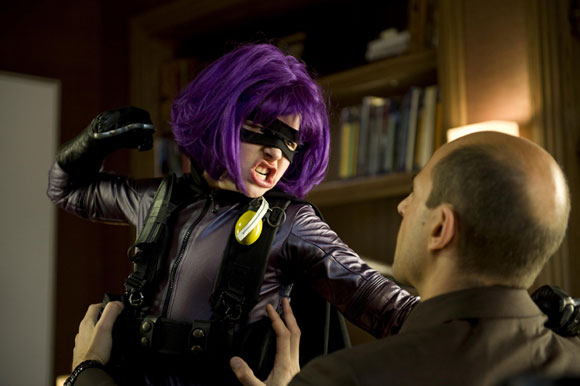Kick-Ass

Chloë Grace Moretz stars as 'Hit Girl' in KICK-ASS. Photo credit: Dan Smith

After sitting through a week of fascinating, independent films, I have no idea why I’m even writing this review. Kick-Ass is a movie carefully engineered to appeal to the child in some of us. It has loads of violence for its own sake, which the director attempts to fetishize but doesn’t know how. Adapted from comics, the film immediately disclaims its hero’s lack of a properly-motivated origin story—e.g. family tragedy, disfigurement, etc. But then the movie fails to engage with the origin story it proffers.
The generic dweeb Dave Lizewski (Aaron Johnson) supplies the unhiply-hip Michael Cera-esque protagonist. One day at the Atomic Comics Cafe, he posits out of nowhere the coolness of being a superhero. The conversation doesn’t even lead into it. “My only super power was being invisible to girls,” he says. The non-existence of super-powers invites discussion of Batman. Success by association? Clearly, the most successful comic book hero adaptation of late has been Christopher Nolan’s first and second installments of the caped crusader’s re-imagined existence. However, this film lacks the narrative depth or the acting chops—actors in their early to late teens.
As Lizewski takes up the mantle, calling himself Kick-Ass, Damon Macready (Nicolas Cage) and Mindy Macready (Chloë Moretz) set up shop as father-and-daughter assassin squad, Big Daddy and Hit Girl. Proficient in firearms, knives and swords, they take a more aggressive approach to vigilante justice—shooting, stabbing and hacking various players in a crime syndicate headed by Frank D’Amico (Mark Strong). Kick-Ass, naturally, gets roped into tagging along with the murderous duo.
The characters are just as cartoonish out of costume as they are behind the mask. Christopher Mintz-Plasse, as Frank D’Amico’s son Chris, plays the stereotypical, reviled rich kid with bodyguards but no real friends. In a foregone conclusion of a plot contrivance, he becomes Red Mist–a name which, for reasons I can’t explain unless you’re married, doesn’t necessarily inspire fear in the hearts of men. On second thought…
In the movie, Dave finds himself in a situation cribbed from Spider-Man, Superman and every other hero movie. Katie Deauxma (Lyndsy Fonseca), the object of his obsession, likes him. After his initial attempt at heroism lands him in the hospital with stab wounds—the only visceral scene in the film, literally and figuratively—Deauxma hears a rumor that he’s gay. In industry parlance, she’s a “fag hag.” He compromises his integrity by exacting revenge on her possessive boyfriend, who happens to be a drug dealer connected to D’Amico’s crime syndicate. This, I guess, is the screenwriter’s way of exonerating him and completely controverting the point of the subplot. In the comic, when Deauxma inevitably discovers that Damon is straight, she has her boyfriend beat him up for lying to her. I find that angle much more intriguing.
The violence is quite excessive, even for an R-rated film. While gunshots are commonplace in movies, knife-stabbings accompanied with generous amounts of blood aren’t as amusing so much as they are disturbingly personal. This differs considerably from the kicky sword fights in Quentin Tarantino’s Kill Bill which maintains a constant degree of ludicrous hacking and slashing, with fake blood squirting out several feet from nearly visible hoses. More so, the eleven-year old Hit Girl does most of the blade-work, unrepentantly. I’m not making a moral argument here. Aesthetically, it reminds me of Pauline Kael’s assessment in her review of Stanley Kubrick’s A Clockwork Orange, “Kubrick, a director with an arctic spirit, is determined to be pornographic, and he has no talent for it.”
The director, Matthew Vaughn (who wrote and directed the hackneyed, narcolepsy-inducing Stardust), doesn’t give us subtle, nuanced degrees of graphic violence purely to realize the story. The story exists only to get the video game-like body count, at one point even employing first-person perspective with night vision goggles, on three thousand screens. Mr. Vaughn doesn’t keep all of the violence corralled in the same, ridiculous universe of physics-defying stunts—a slippery slope between titillation and snuff, cranked up to eleven for unapologetic, violence-loving American audiences.
While the film is rated R, a fact the marketing has embraced (as did the original comic with the cover tag line, “Sickening Violence: Just the Way You Like It!”), I can’t imagine what sane adult wants to watch this. It seems much more obviously designed to appeal to kids, or early twenty-somethings handicapped by growing up on Kevin Smith’s one-dimensional sense of humor. Attempting to be a super-hero movie and a coming-of-age story, it possesses neither the grit of The Dark Knight, nor the intuition and spirit of Penny Marshall’s Big—a far cleverer story about the realities of growing up. Between this, the two Hulk movies, and Superman Returns, I think that the comic book goldmine has been exhausted. The greatest insight this film offers is when it self-criticizes by pointing out to us that, despite his mortality, Batman had virtually unlimited resources—intellect, for example.
 Kick-Ass • Dolby® Digital surround sound in select theatres • Aspect Ratio: 2:39:1 • Running Time: 117 minutes • MPAA Rating: R for strong brutal violence throughout, pervasive language, sexual content, nudity and some drug use – some involving children. • Distributed by Lionsgate
Kick-Ass • Dolby® Digital surround sound in select theatres • Aspect Ratio: 2:39:1 • Running Time: 117 minutes • MPAA Rating: R for strong brutal violence throughout, pervasive language, sexual content, nudity and some drug use – some involving children. • Distributed by Lionsgate